Recent Developments in DC-DC Converter Topologies for Light Electric Vehicle Charging: A Critical Review
Abstract
1. Introduction
- This paper fills the gap in research by reviewing recent works on DC-DC converter topologies used for LEV charging—critiquing each implementation. Finally, areas of improvement and future research objectives are suggested in this regard.
- Furthermore, this paper also describes recent issues and potential future areas of research in LEV charging. This intends to encourage researchers to take up research which will aim to address these issues and open up research avenues.
2. LEV Charging Infrastructure Overview
- DC-DC stage: This DC-DC conversion stage is responsible for controlling the LEV battery charging process. The switch duty cycle is controlled by the battery voltage status/required charging current.
3. Review Methodology
4. DC-DC Converter Topologies for LEV Charging
4.1. On-Board Charging
4.1.1. Isolated DC-DC Converter Topologies
- There is the obvious advantage of galvanic isolation between the battery circuit and supply, thus ensuring user safety.
- The turns ratio of the high frequency transformer may be leveraged to achieve a wider voltage gain range, thus making the converter suitable for usage with a wider load range.
4.1.2. Non-Isolated Converters
4.2. Off-Board Charging
4.2.1. Isolated Converter
4.2.2. Non-Isolated Converter
5. Summary, Gaps, and Improvement Measures in Reviewed Literature
6. Challenges and Future Trends in LEV Charging
6.1. Wireless Charging
6.2. Fast Charging and High-Current Converter Topologies
6.3. Fully Renewable-Based Charging System
- Integration with solar PV will result in an increased number of power conversion stages, on account of the addition of a power converter for PV MPPT. To counteract this, a single power conversion stage can be used, which may be responsible for both maximum power point control and battery charging control. While such a scheme may result in improved efficiency, the complexity of control may also increase.
- Another key challenge in implementing such systems is the continuity of power supply. Supply intermittency may arise from fluctuations in—or lack of—solar irradiation during the day. For this purpose, it is imperative to provide a backup ESU [109,110]. The sizing of such an ESU must take the sizing of the PV system into consideration. However, this may result in increased maintenance costs.
- Furthermore, there must also be a provision for usage of surplus power in such charging stations when there is no EV available, and the ESU is fully charged. This issue can be partially alleviated if this charging station is to be implemented as a part of an extended DC distribution network, as discussed by [16,112,113].
6.4. Use of Wide Band-Gap Electronics
6.5. Advanced Charging Techniques
6.6. Standardization of LEV Charging
6.7. Electrical Insulation Considerations
7. Conclusions
- Wireless charging techniques, their optimization and safety aspects.
- Fast charging through high current DC-DC converters, and battery swapping.
- Integration of renewable energy sources such as solar PV into charging system, ensuing challenges and how to overcome them.
- Use of superior wide band-gap semiconductor switches for implementing LEV fast chargers, and barriers in their adoption.
- Advanced charging techniques such as reflex charging and constant temperature control.
- Compatibility of LEVs with standardized charging stations and battery swapping stations.
- Considerations with respect to electrical insulation requirements and necessity for insulation monitoring.
Author Contributions
Funding
Institutional Review Board Statement
Informed Consent Statement
Acknowledgments
Conflicts of Interest
References
- International Energy Agency. Global EV Outlook 2022; IEA: Paris, France, 2022. [Google Scholar]
- Will, S.; Luger-Bazinger, C.; Schmitt, M.; Zankl, C. Towards the future of sustainable mobility: Results from a European survey on (electric) powered-two wheelers. Sustainability 2021, 13, 7151. [Google Scholar] [CrossRef]
- Sasidharan, C.; Tyagi, B.; Rajah, V. Light electric vehicles and their charging aspects. In Electric Vehicles; Springer: Singapore, 2021; pp. 33–51. [Google Scholar]
- Mouli, G.R.C.; van Duijsen, P.; Grazian, F.; Jamodkar, A.; Bauer, P.; Isabella, O. Sustainable e-bike charging station that enables ac, dc andwireless charging from solar energy. Energies 2020, 13, 3549. [Google Scholar] [CrossRef]
- Ather Energy. Available online: https://www.atherenergy.com/ (accessed on 15 October 2022).
- Hero Electric Bikes and Scooters. Available online: https://heroelectric.in/bikes/ (accessed on 15 October 2022).
- Okinawa Electric PraisePro. Available online: https://okinawascooters.com/products/praisepro/# (accessed on 15 October 2022).
- Mahindra Treo. Available online: https://www.mahindraelectric.com/vehicles/treo-electric-auto/ (accessed on 15 October 2022).
- Piaggio Ape E-City. Available online: https://piaggio-cv.co.in/ape-e-city/ (accessed on 15 October 2022).
- Terra Motors Y4A. Available online: https://terramotors.in/y4a (accessed on 15 October 2022).
- Vaideeswaran, V.; Hariharan, S.; Jayadarshan, N.S.; Pragadheesan, K. Review on Electric Two Wheeler Chargers and International Standards. In Proceedings of the 2021 Innovations in Power and Advanced Computing Technologies (i-PACT), Kuala Lumpur, Malaysia, 27–29 November 2021; pp. 1–5. [Google Scholar]
- Rafi, M.A.H.; Bauman, J. A Comprehensive Review of DC Fast-Charging Stations with Energy Storage: Architectures, Power Converters, and Analysis. IEEE Trans. Transp. Electrif. 2021, 7, 345–368. [Google Scholar] [CrossRef]
- Yilmaz, M.; Krein, P.T. Review of Battery Charger Topologies, Charging Power Levels, and Infrastructure for Plug-In Electric and Hybrid Vehicles. IEEE Trans. Power Electron. 2013, 28, 2151–2169. [Google Scholar] [CrossRef]
- IEEE Power and Energy Society. IEEE Recommended Practice and Requirements for Harmonic Control in Electric Power Systems. IEEE Std. 2014, 2014, 519–2014. [Google Scholar]
- International Electrotechnical Commission. Electromagnetic Compatibility (EMC)—Part 3-2: Limits—Limits for Harmonic Current Emissions (Equipment Input Current ≤16 A per Phase); IEC 61000-3-2:2018; International Electrotechnical Commission (IEC): Geneva, Switzerland, 2018. [Google Scholar]
- Lin, B.-R. Analysis and Implementation of a Frequency Control DC–DC Converter for Light Electric Vehicle Applications. Electronics 2021, 10, 1623. [Google Scholar] [CrossRef]
- Gupta, J.; Singh, B. Single-Stage Isolated Bridgeless Charger for Light Electric Vehicle with Improved Power Quality. IEEE Trans. Ind. Appl. 2022, 58, 6357–6367. [Google Scholar] [CrossRef]
- Gupta, J.; Singh, B. Bridgeless Isolated Positive Output Luo Converter Based High Power Factor Single Stage Charging Solution for Light Electric Vehicles. IEEE Trans. Ind. Appl. 2022, 58, 732–741. [Google Scholar] [CrossRef]
- Chaudhary, C.; Mishra, S.; Nangia, U. A Bridgeless Isolated Zeta Converter for Battery Charging Aided with Solar Photovoltaic System. In Proceedings of the 2021 International Conference on Smart Generation Computing, Communication and Networking (SMART GENCON), Pune, India, 29–30 October 2021; pp. 1–6. [Google Scholar] [CrossRef]
- Shukla, T.; Kalla, U.K. A Modified Non-bridged Cuk Converter based Electric Vehicle Charger with Reduced Components Count. In Proceedings of the 2021 IEEE 2nd International Conference on Smart Technologies for Power, Energy and Control (STPEC), Bilaspur, India, 19–22 December 2021; pp. 1–6. [Google Scholar] [CrossRef]
- Pandey, R.; Singh, B. A Cuk Converter and Resonant LLC Converter Based E-Bike Charger for Wide Output Voltage Variations. IEEE Trans. Ind. Appl. 2021, 57, 2682–2691. [Google Scholar] [CrossRef]
- Kim, D.-H.; Kim, M.-S.; Nengroo, S.H.; Kim, C.-H.; Kim, H.-J. LLC Resonant Converter for LEV (Light Electric Vehicle) Fast Chargers. Electronics 2019, 8, 362. [Google Scholar] [CrossRef]
- Dixit, A.; Gangavarapu, S.; Rathore, A.K. High-Efficiency Discontinuous Current-Mode Power Factor Correction-Based Plug-In Battery Charger for Local e-Transportation. IEEE Trans. Transp. Electrif. 2021, 7, 1134–1145. [Google Scholar] [CrossRef]
- Gumera, X.D.; Caberos, A.; Huang, S.-C. Design and Implementation of a High Efficiency Cost Effective EV Charger Using LLC Resonant Converter. In Proceedings of the 2017 Asian Conference on Energy, Power and Transportation Electrification (ACEPT), Singapore, 24–26 October 2017; pp. 1–6. [Google Scholar] [CrossRef]
- Sayed, S.S.; Massoud, A.M. Review on State-of-the-Art Unidirectional Non-Isolated Power Factor Correction Converters for Short-/Long-Distance Electric Vehicles. IEEE Access 2022, 10, 11308–11340. [Google Scholar] [CrossRef]
- Faridpak, B.; Farrokhifar, M.; Nasiri, M.; Alahyari, A.; Sadoogi, N. Developing a super-lift luo-converter with integration of buck converters for electric vehicle applications. CSEE J. Power Energy Syst. 2020, 7, 811–820. [Google Scholar] [CrossRef]
- Jazi, H.N.; Goudarzian, A.; Pourbagher, R.; Derakhshandeh, S.Y. PI and PWM Sliding Mode Control of POESLL Converter. IEEE Trans. Aerosp. Electron. Syst. 2017, 53, 2167–2177. [Google Scholar] [CrossRef]
- Kouzou, A. Power Factor Correction Circuits. In Power Electronics Handbook; Elsevier: Amsterdam, The Netherlands, 2018; pp. 529–569. [Google Scholar] [CrossRef]
- Jiang, L.; Wan, J.; Li, Y.; Huang, C.; Liu, F.; Wang, H.; Sun, Y.; Cao, Y. A New Push-Pull DC/DC Converter Topology With Complementary Active Clamped. IEEE Trans. Ind. Electron. 2022, 69, 6445–6449. [Google Scholar] [CrossRef]
- Moghaddam, A.F.; van den Bossche, A. Forward Converter Current Fed Equalizer for Lithium Based Batteries in Ultralight Electrical Vehicles. Electronics 2019, 8, 408. [Google Scholar] [CrossRef]
- Lee, H.-S.; Kang, B.; Kim, W.-S.; Yoon, S.-J. Reduction of input voltage/current ripples of boost half-bridge DC-DC converter for photovoltaic micro-inverter. Sol. Energy 2019, 188, 1084–1101. [Google Scholar] [CrossRef]
- Jou, H.-L.; Huang, J.-J.; Wu, J.-C.; Wu, K.-D. Novel Isolated Multilevel DC–DC Power Converter. IEEE Trans. Power Electron. 2016, 31, 2690–2694. [Google Scholar] [CrossRef]
- Gupta, J.; Kushwaha, R.; Singh, B. Improved Power Quality Transformerless Single-Stage Bridgeless Converter Based Charger for Light Electric Vehicles. IEEE Trans. Power Electron. 2021, 36, 7716–7724. [Google Scholar] [CrossRef]
- Shukla, T.; Kalla, U.K. A Single-Stage positive Cuk Converter based Charging System for Light Electric Vehicle Applications. In Proceedings of the 2021 IEEE 2nd International Conference on Smart Technologies for Power, Energy and Control (STPEC), Bilaspur, India, 19–22 December 2021; pp. 1–6. [Google Scholar] [CrossRef]
- Singh, B.; Gupta, J. Improved Power Quality On-Board Charging Solution for Light Electric Vehicles. In Proceedings of the 2021 IEEE Transportation Electrification Conference & Expo (ITEC), Chicago, IL, USA, 21–25 June 2021; pp. 462–467. [Google Scholar] [CrossRef]
- Gupta, J.; Kushwaha, R.; Singh, B. An Isolated Improved Power Quality Battery Charger for a Light Electric Vehicle. In Proceedings of the 2020 IEEE International Conference on Power Electronics, Smart Grid and Renewable Energy (PESGRE2020), Cochin, India, 2–4 January 2020; pp. 1–6. [Google Scholar] [CrossRef]
- Kushwaha, R.; Singh, B. Power Factor Correction in EV Charger with Bridgeless Zeta-SEPIC Converter. In Proceedings of the 2019 IEEE Energy Conversion Congress and Exposition (ECCE), Baltimore, MD, USA, 29 September–3 October 2019; pp. 121–128. [Google Scholar] [CrossRef]
- Kushwaha, R.; Singh, B. Power Factor Improvement in Modified Bridgeless Landsman Converter Fed EV Battery Charger. IEEE Trans. Veh. Technol. 2019, 68, 3325–3336. [Google Scholar] [CrossRef]
- Kushwaha, R.; Singh, B. Interleaved Landsman Converter Fed EV Battery Charger with Power Factor Correction. IEEE Trans. Ind. Appl. 2020, 56, 4179–4192. [Google Scholar] [CrossRef]
- Sankar, U.A.; Mallik, A.; Khaligh, A. Duty compensated reduced harmonic control for a single-phase H-bridge PFC converter. In Proceedings of the 2018 IEEE Applied Power Electronics Conference and Exposition (APEC), San Antonio, TX, USA, 4–8 March 2018; pp. 1996–2000. [Google Scholar] [CrossRef]
- Chaurasiya, S.; Singh, B. A High-Power Density Portable Charger for E-Mopeds and E-Rickshaw. In Proceedings of the 2021 IEEE 4th International Conference on Computing, Power and Communication Technologies (GUCON), Kuala Lumpur, Malaysia, 24–26 September 2021; pp. 1–7. [Google Scholar] [CrossRef]
- He, P.; Khaligh, A. Comprehensive Analyses and Comparison of 1 kW Isolated DC–DC Converters for Bidirectional EV Charging Systems. IEEE Trans. Transp. Electrif. 2017, 3, 147–156. [Google Scholar] [CrossRef]
- Shreya, K.; Srivastava, H.; Kumar, P.; Ramanathan, G.; Madhavan, P.; Bharatiraja, C. CUK converter fed resonant LLC converter based electric bike fast charger for efficient cc/cv charging solution. J. Appl. Sci. Eng. 2021, 24, 331–338. [Google Scholar] [CrossRef]
- Syah, M.N.; Firmansyah, E.; Utomo, D.R. Interleaved Bidirectional DC-DC Converter Operation Strategies and Problem Challenges: An Overview. In Proceedings of the 2022 IEEE International Conference in Power Engineering Application (ICPEA), Shah Alam, Malaysia, 7–8 March 2022; pp. 1–6. [Google Scholar] [CrossRef]
- Sharma, U.; Singh, B. A Multistep Bidirectional Onboard Charger for Light Electric Vehicles Using Interleaved Luo Converter. In Proceedings of the 2021 International Conference on Sustainable Energy and Future Electric Transportation (SEFET), Hyderabad, India, 21–23 January 2021; pp. 1–5. [Google Scholar] [CrossRef]
- Sharma, U.; Singh, B. A Bidirectional Onboard Charging System for E-Rickshaw Using Interleaved SEPIC Converter. In Proceedings of the 2020 IEEE 17th India Council International Conference (INDICON), New Delhi, India, 10–13 December 2020; pp. 1–5. [Google Scholar] [CrossRef]
- Sharma, U.; Singh, B. An Onboard Bidirectional Charger for Light Electric Vehicles Using Interleaved ZETA Converter. In Proceedings of the 2020 International Conference on Power, Instrumentation, Control and Computing (PICC), Thrissur, India, 17–19 December 2020; pp. 1–6. [Google Scholar] [CrossRef]
- Lai, C.-M. Development of a Novel Bidirectional DC/DC Converter Topology with High Voltage Conversion Ratio for Electric Vehicles and DC-Microgrids. Energies 2016, 9, 410. [Google Scholar] [CrossRef]
- Wang, J.; Zhang, Y.; Elshaer, M.; Perdikakis, W.; Yao, C.; Zou, K.; Xu, Z.; Chen, C. Nonisolated Electric Vehicle Chargers: Their Current Status and Future Challenges. IEEE Electrif. Mag. 2021, 9, 23–33. [Google Scholar] [CrossRef]
- Sharma, U.; Singh, B. A Bidirectional Charger for Light Electric Vehicle Using Coupled-Inductor based High Gain SEPIC Converter. In Proceedings of the 2021 IEEE 2nd International Conference on Smart Technologies for Power, Energy and Control (STPEC), Bilaspur, India, 19–22 December 2021; pp. 1–6. [Google Scholar] [CrossRef]
- Gupta, J.; Singh, B. A Switched Capacitor-Coupled Inductor Based High Gain Buck Converter with Power Factor Pre-regulator for LEVs Charging Application. In Proceedings of the 2021 IEEE 4th International Conference on Computing, Power and Communication Technologies (GUCON), Kuala Lumpur, Malaysia, 24–26 September 2021; pp. 1–6. [Google Scholar] [CrossRef]
- Blinov, A.; Verbytskyi, I.; Zinchenko, D.; Vinnikov, D.; Galkin, I. Modular Battery Charger for Light Electric Vehicles. Energies 2020, 13, 774. [Google Scholar] [CrossRef]
- Gupta, J.; Kushwaha, R.; Singh, B.; Khadkikar, V. Improved Power Quality Charging System Based on High Step-Down Gain Bridgeless SEPIC APFC for Light Electric Vehicles. IEEE Trans. Ind. Appl. 2022, 58, 423–434. [Google Scholar] [CrossRef]
- Ramanathan, G.; Bharatiraja, C. Design of mono stage bridgeless converter for light electric vehicles charging. Mater. Today Proc. 2022, 52, 1530–1536. [Google Scholar] [CrossRef]
- Hussein, B.; Alsalemi, A.; Ben-Brahim, L. High-Gain Non-isolated Single-Switch DC-DC Converters in Power Factor Correction Rectifiers: A Performance Assessment. In Proceedings of the 2022 3rd International Conference on Smart Grid and Renewable Energy (SGRE), Doha, Qatar, 20–22 March 2022; pp. 1–6. [Google Scholar] [CrossRef]
- Sharma, U.; Singh, B. A Non-isolated Onboard Charger for Electric Vehicle. In Proceedings of the 2021 IEEE Transportation Electrification Conference & Expo (ITEC), Chicago, IL, USA, 21–25 June 2021; pp. 446–451. [Google Scholar] [CrossRef]
- Kumar, A.D.; Gupta, J.; Singh, B. A Single-Stage Charger for LEV Application based on Quadratic Buck-Boost Converter Topology. In Proceedings of the 2022 IEEE IAS Global Conference on Emerging Technologies (GlobConET), Arad, Romania, 20–22 May 2022; pp. 321–326. [Google Scholar] [CrossRef]
- Yuan, J.; Dorn-Gomba, L.; Callegaro, A.D.; Reimers, J.; Emadi, A. A Review of Bidirectional On-Board Chargers for Electric Vehicles. IEEE Access 2021, 9, 51501–51518. [Google Scholar] [CrossRef]
- LiveWire. Available online: https://www.livewire.com/livewire-one-electric-motorcycle#livewire-one-specs (accessed on 15 October 2022).
- Mouli, G.R.C.; Schijffelen, J.; van den Heuvel, M.; Kardolus, M.; Bauer, P. A 10 kW Solar-Powered Bidirectional EV Charger Compatible with Chademo and COMBO. IEEE Trans. Power Electron. 2019, 34, 1082–1098. [Google Scholar] [CrossRef]
- Çalışkan, E.; Ustun, O. Smart Efficiency Tracking for Novel Switch—LLC Converter for Battery Charging Applications. Energies 2022, 15, 1861. [Google Scholar] [CrossRef]
- Askarian, I.; Palevani, M.; Knight, A. A new method to achieve ZVS for DC-DC Dual Active Bridge (DAB) converters used between electric vehicles and DC micro-grids. In Proceedings of the 2017 IEEE Second International Conference on DC Microgrids (ICDCM), Nuremburg, Germany, 27–29 June 2017; pp. 102–105. [Google Scholar] [CrossRef]
- ElMenshawy, M.; Massoud, A. Development of Modular DC-DC Converters for Low-Speed Electric Vehicles Fast Chargers. Alex. Eng. J. 2021, 60, 1067–1083. [Google Scholar] [CrossRef]
- Ghosh, S.; Singh, B. A Reconfigurable Dual Active Bridge Converter with Wide ZVS Range for Charging of Electric Vehicles. In Proceedings of the 2020 IEEE International Conference on Power Electronics, Drives and Energy Systems (PEDES), Jaipur, India, 16–19 December 2020; pp. 1–6. [Google Scholar] [CrossRef]
- Piasecki, S.; Zaleski, J.; Jasinski, M.; Bachman, S.; Turzyński, M. Analysis of AC/DC/DC Converter Modules for Direct Current Fast-Charging Applications. Energies 2021, 14, 6369. [Google Scholar] [CrossRef]
- Qin, Z.; Shen, Z.; Blaabjerg, F.; Bauer, P. Transformer Current Ringing in Dual Active Bridge Converters. IEEE Trans. Ind. Electron. 2021, 68, 12130–12140. [Google Scholar] [CrossRef]
- Singh, A.; Shaha, S.S.; Nikhil, P.G.; Sekhar, Y.R.; Saboor, S.; Ghosh, A. Design and Analysis of a Solar-Powered Electric Vehicle Charging Station for Indian Cities. World Electr. Veh. J. 2021, 12, 132. [Google Scholar] [CrossRef]
- Singh, K.; Mishra, A.K.; Singh, B.; Sahay, K. Solar powered battery charging scheme for light electric vehicles (LEVs). Int. J. Emerg. Electr. Power Syst. 2021, 22, 101–111. [Google Scholar] [CrossRef]
- Atawi, I.E.; Hendawi, E.; Zaid, S.A. Analysis and Design of a Standalone Electric Vehicle Charging Station Supplied by Photovoltaic Energy. Processes 2021, 9, 1246. [Google Scholar] [CrossRef]
- Nachinarkiniyan, S.; Subramanian, K. Off-board electric vehicle battery charger using PV array. IET Electr. Syst. Transp. 2020, 10, 291–300. [Google Scholar] [CrossRef]
- Alatai, S.; Salem, M.; Alhamrouni, I.; Ishak, D.; Bughneda, A.; Kamarol, M. Design Methodology and Analysis of Five-Level LLC Resonant Converter for Battery Chargers. Sustainability 2022, 14, 8255. [Google Scholar] [CrossRef]
- Lai, C.-M.; Li, Y.-H.; Cheng, Y.-H.; Teh, J. A High-Gain Reflex-Based Bidirectional DC Charger with Efficient Energy Recycling for Low-Voltage Battery Charging-Discharging Power Control. Energies 2018, 11, 623. [Google Scholar] [CrossRef]
- Hosseini, S.H.; Ghazi, R.; Heydari-Doostabad, H. An Extendable Quadratic Bidirectional DC–DC Converter for V2G and G2V Applications. IEEE Trans. Ind. Electron. 2021, 68, 4859–4869. [Google Scholar] [CrossRef]
- Kurs, A.; Karalis, A.; Moffatt, R.; Joannopoulos, J.D.; Fisher, P.; Soljačić, M. Wireless Power Transfer via Strongly Coupled Magnetic Resonances. Science 2007, 317, 83–86. [Google Scholar] [CrossRef] [PubMed]
- Beh, H.Z.Z.; Covic, G.A.; Boys, J.T. Wireless Fleet Charging System for Electric Bicycles. IEEE J. Emerg. Sel. Top. Power Electron. 2015, 3, 75–86. [Google Scholar] [CrossRef]
- Jiang, W.; Xu, S.; Li, N.; Lin, Z.; Williams, B.W. Wireless power charger for light electric vehicles. In Proceedings of the 2015 IEEE 11th International Conference on Power Electronics and Drive Systems, Sydney, Australia, 9–12 June 2015; pp. 562–566. [Google Scholar] [CrossRef]
- Joseph, P.K.; Elangovan, D.; Arunkumar, G. Linear control of wireless charging for electric bicycles. Appl. Energy 2019, 255, 113898. [Google Scholar] [CrossRef]
- Xiong, M.; Liu, D.; Zhang, Z.; Li, W. Design and effect analysis of wireless energy transmission device for electric vehicle. In Proceedings of the 2021 International Conference on Information Control, Electrical Engineering and Rail Transit (ICEERT), Lanzhou, China, 30 October 2021–1 November 2021; pp. 91–94. [Google Scholar] [CrossRef]
- Hvarchilkov, D.S.; Dimitrov, V.V.; Arnaudov, D.D. Resonant Converter for Inductive Charging of Light Electric Vehicles. In Proceedings of the 2018 IEEE XXVII International Scientific Conference Electronics-ET, Sozopol, Bulgaria, 3–15 September 2018; pp. 1–4. [Google Scholar] [CrossRef]
- Joseph, P.K.; Elangovan, D. A review on renewable energy powered wireless power transmission techniques for light electric vehicle charging applications. J. Energy Storage 2018, 16, 145–155. [Google Scholar] [CrossRef]
- Ashfaq, M.; Butt, O.; Selvaraj, J.; Rahim, N. Assessment of electric vehicle charging infrastructure and its impact on the electric grid: A review. Int. J. Green Energy 2021, 18, 657–686. [Google Scholar] [CrossRef]
- Trivino-Cabrera, A.; Gonzalez-Gonzalez, J.M.; Aguado, J.A. Design and Implementation of a Cost-Effective Wireless Charger for an Electric Bicycle. IEEE Access 2021, 9, 85277–85288. [Google Scholar] [CrossRef]
- Chen, Y.; Yang, N.; Yang, B.; Dai, R.; He, Z.; Mai, R.; Gao, S. Two-/three-coil hybrid topology and coil design for WPT system charging electric bicycles. IET Power Electron. 2019, 12, 2501–2512. [Google Scholar] [CrossRef]
- Liu, S.; Li, X.; Yang, L. Three-coil structure-based WPT system design for electric bike CC and CV charging without communication. IET Electr. Power Appl. 2019, 13, 1318–1327. [Google Scholar] [CrossRef]
- Shevchenko, V.; Pakhaliuk, B.; Zakis, J.; Veligorskyi, O.; Luszcz, J.; Husev, O.; Lytvyn, O.; Matiushkin, O. Closed-Loop Control System Design for Wireless Charging of Low-Voltage EV Batteries with Time-Delay Constraints. Energies 2021, 14, 3934. [Google Scholar] [CrossRef]
- Liu, S.; Zhao, X.; Wu, Y.; Zhou, L.; Li, Y.; Mai, R.; He, Z. Efficiency Improvement of Dual-Receiver WPT Systems Based on Partial Power Processing Control. IEEE Trans. Power Electron. 2022, 37, 7456–7469. [Google Scholar] [CrossRef]
- Liorni, I.; Bottauscio, O.; Guilizzoni, R.; Ankarson, P.; Bruna, J.; Fallahi, A.; Harmon, S.; Zucca, M. Assessment of Exposure to Electric Vehicle Inductive Power Transfer Systems: Experimental Measurements and Numerical Dosimetry. Sustainability 2020, 12, 4573. [Google Scholar] [CrossRef]
- Vaka, R.; Keshri, R.K. Evaluation and selection of shielding methods for wireless charging of e-rickshaw. Electr. Eng. 2020, 102, 1005–1019. [Google Scholar] [CrossRef]
- Naradhipa, A.M.; Kim, S.; Choi, S.; Jung, J.-H.; Joo, J.-H.; Ahn, D.-S.; Lee, Y.-S.; Yeo, I.-Y. A Compact 700kHz 1.8kW GaN-based Transistor Low Voltage High Current DC-DC Converter for xEV using Planar Matrix Transformer. In Proceedings of the 2019 10th International Conference on Power Electronics and ECCE Asia (ICPE 2019-ECCE Asia), Busan, Korea, 27–30 May 2019; pp. 1–6. [Google Scholar] [CrossRef]
- Kim, B.; Kim, K.; Choi, S. A 800V/14V Soft-switched Converter with Low-Voltage Rating of Switch for xEV applications. In Proceedings of the 2018 International Power Electronics Conference (IPEC-Niigata 2018-ECCE Asia), Niigata, Japan, 20–24 May 2018; pp. 256–260. [Google Scholar] [CrossRef]
- Hong, D.-Y.; Kong, S.-J.; Lee, J.-Y. Design of a 5.6 kW EV low-voltage DC/DC converter based on full-bridge converter with input series output parallel structure. J. Power Electron. 2022, 22, 395–405. [Google Scholar] [CrossRef]
- Zheng, Y.; Li, S.; Smedley, K.M. Nonisolated High Step-Down Converter with ZVS and Low Current Ripples. IEEE Trans. Ind. Electron. 2019, 66, 1068–1079. [Google Scholar] [CrossRef]
- Khalili, S.; Farzanehfard, H.; Esteki, M. High step-down dc–dc converter with low voltage stress and wide soft-switching range. IET Power Electron. 2020, 13, 3001–3008. [Google Scholar] [CrossRef]
- Fatahi, S.A.S.; Esteki, M.; Farzanehfard, H. A Soft Switching Interleaved High Step-down Converter with Low Voltage Stress. In Proceedings of the 2021 12th Power Electronics, Drive Systems, and Technologies Conference (PEDSTC), Tabriz, Iran, 2–4 February 2021; pp. 1–6. [Google Scholar] [CrossRef]
- Amiri, M.; Farzanehfard, H. An Interleaved Nonisolated ZVS Ultrahigh Step-Down DC–DC Converter with Low Voltage Stress. IEEE Trans. Ind. Electron. 2019, 66, 7663–7671. [Google Scholar] [CrossRef]
- Mayer, R.; el Kattel, M.B.; Oliveira, S.V.G. Multiphase Interleaved Bidirectional DC/DC Converter with Coupled Inductor for Electrified-Vehicle Applications. IEEE Trans. Power Electron. 2021, 36, 2533–2547. [Google Scholar] [CrossRef]
- Moradisizkoohi, H.; Elsayad, N.; Mohammed, O.A. A Voltage-Quadrupler Interleaved Bidirectional DC–DC Converter with Intrinsic Equal Current Sharing Characteristic for Electric Vehicles. IEEE Trans. Ind. Electron. 2021, 68, 1803–1813. [Google Scholar] [CrossRef]
- Revankar, S.R.; Kalkhambkar, V.N. Grid integration of battery swapping station: A review. J. Energy Storage 2021, 41, 102937. [Google Scholar] [CrossRef]
- Esmaeili, S.; Anvari-Moghaddam, A.; Jadid, S. Optimal Operation Scheduling of a Microgrid Incorporating Battery Swapping Stations. IEEE Trans. Power Syst. 2019, 34, 5063–5072. [Google Scholar] [CrossRef]
- Wang, Y.; Ding, W.; Huang, L.; Wei, Z.; Liu, H.; Stankovic, J.A. Toward Urban Electric Taxi Systems in Smart Cities: The Battery Swapping Challenge. IEEE Trans. Veh. Technol. 2018, 67, 1946–1960. [Google Scholar] [CrossRef]
- Arif, S.M.; Lie, T.T.; Seet, B.C.; Ayyadi, S.; Jensen, K. Review of Electric Vehicle Technologies, Charging Methods, Standards and Optimization Techniques. Electronics 2021, 10, 1910. [Google Scholar] [CrossRef]
- Andwari, A.M.; Pesiridis, A.; Rajoo, S.; Martinez-Botas, R.; Esfahanian, V. A review of Battery Electric Vehicle technology and readiness levels. Renew. Sustain. Energy Rev. 2017, 78, 414–430. [Google Scholar] [CrossRef]
- Kumar, G.; Singh, B. Cuk Converter Derived Dual-Input Charger for PV Panel Mounted Light Electric Vehicles. In Proceedings of the 2021 IEEE 6th International Conference on Computing, Communication and Automation (ICCCA), Arad, Romania, 17–19 December 2021; pp. 70–76. [Google Scholar] [CrossRef]
- Singh, A.K.; Chinmaya, K.A.; Badoni, M. Solar PV and Grid Based Isolated Converter for Plug-in Electric Vehicles. IET Power Electron. 2019, 12, 3707–3715. [Google Scholar] [CrossRef]
- Singh, A.K.; Badoni, M.; Tatte, Y.N. A Multifunctional Solar PV and Grid Based On-Board Converter for Electric Vehicles. IEEE Trans. Veh. Technol. 2020, 69, 3717–3727. [Google Scholar] [CrossRef]
- Gupta, J.; Singh, B.; Kushwaha, R. A Rooftop Solar PV Assisted On-Board Enhanced Power Quality Charging System for E-Rickshaw. In Proceedings of the 2020 International Conference on Power, Instrumentation, Control and Computing (PICC), Thrissur, India, 17–19 December 2020; pp. 1–6. [Google Scholar] [CrossRef]
- Kumar, D.; Saxena, A.R. A battery integrated three-port bidirectional charger/discharger for light electric vehicles with G2V and V2G power flow capability. Int. J. Circuit Theory Appl. 2021, 49, 2909–2934. [Google Scholar] [CrossRef]
- Singh, K.; Mishra, A.K.; Singh, B.; Sahay, K. Cost-Effective Solar Powered Battery Charging System for Light Electric Vehicles (LEVs). In Proceedings of the 2019 International Conference on Computing, Power and Communication Technologies, GUCON 2019, NCR, New Delhi, India, 27–28 September 2019. [Google Scholar]
- Ashique, R.H.; Salam, Z.; Aziz, M.J.b.A.; Bhatti, A.R. Integrated photovoltaic-grid dc fast charging system for electric vehicle: A review of the architecture and control. Renew. Sustain. Energy Rev. 2017, 69, 1243–1257. [Google Scholar] [CrossRef]
- Bhatti, A.R.; Salam, Z.; Aziz, M.J.B.A.; Yee, K.P.; Ashique, R.H. Electric vehicles charging using photovoltaic: Status and technological review. Renew. Sustain. Energy Rev. 2016, 54, 34–47. [Google Scholar] [CrossRef]
- Bucciarelli, A.G.; Berrino, C.H.; Silva, L.I. Design and Calculation of a Solar Charge Station for Light Electric Vehicles. In Proceedings of the 2018 Argentine Conference on Automatic Control (AADECA), Buenos Aires, Argentina, 7–9 November 2018; pp. 1–6. [Google Scholar] [CrossRef]
- Sharma, U.; Singh, B. A Reliable Level-1 Onboard Charger of a Light Electric Vehicle for Smart Homes with Seamless Transition Capability. In Proceedings of the 2021 IEEE 6th International Conference on Computing, Communication and Automation (ICCCA), Arad, Romania, 17–19 December 2021; pp. 208–213. [Google Scholar] [CrossRef]
- Sharma, U.; Singh, B. Seamless Integration of An Onboard Charger in a Smart Home. In Proceedings of the 2021 IEEE 4th International Conference on Computing, Power and Communication Technologies (GUCON), Kuala Lumpur, Malaysia, 24–26 September 2021; pp. 1–6. [Google Scholar] [CrossRef]
- U.S. Department of Energy. Electrical and Electronics Technical Team Roadmap. U.S. DRIVE Partnership, no. October, 2017. Available online: https://www.energy.gov/sites/prod/files/2017/11/f39/EETT%20Roadmap%2010-27-17.pdf (accessed on 1 December 2022).
- Hawes, M. Emerging Solutions to Hybrid & Electric Vehicle DC: DC Converter Design and Test; KEYSIGHT: Santa Rosa, CA, USA, 2022; Available online: https://www.keysight.com/my/en/assets/7018-05971/white-papers/5992-2669.pdf?success=true (accessed on 1 December 2022).
- Millan, J.; Godignon, P.; Perpina, X.; Perez-Tomas, A.; Rebollo, J. A Survey of Wide Bandgap Power Semiconductor Devices. IEEE Trans. Power Electron. 2014, 29, 2155–2163. [Google Scholar] [CrossRef]
- Chakraborty, S.; Vu, H.-N.; Hasan, M.M.; Tran, D.-D.; el Baghdadi, M.; Hegazy, O. DC-DC Converter Topologies for Electric Vehicles, Plug-in Hybrid Electric Vehicles and Fast Charging Stations: State of the Art and Future Trends. Energies 2019, 12, 1569. [Google Scholar] [CrossRef]
- Li, B.; Li, Q.; Lee, F.C.; Liu, Z.; Yang, Y. A High-Efficiency High-Density Wide-Bandgap Device-Based Bidirectional On-Board Charger. IEEE J. Emerg. Sel. Top. Power Electron. 2018, 6, 1627–1636. [Google Scholar] [CrossRef]
- Whitaker, B.; Barkley, A.; Cole, Z.; Passmore, B.; Martin, D.; McNutt, T.R.; Lostetter, A.B.; Lee, J.S.; Shiozaki, K. A High-Density, High-Efficiency, Isolated On-Board Vehicle Battery Charger Utilizing Silicon Carbide Power Devices. IEEE Trans. Power Electron. 2014, 29, 2606–2617. [Google Scholar] [CrossRef]
- Fu, M.; Fei, C.; Yang, Y.; Li, Q.; Lee, F.C. A GaN-Based DC–DC Module for Railway Applications: Design Consideration and High-Frequency Digital Control. IEEE Trans. Ind. Electron. 2020, 67, 1638–1647. [Google Scholar] [CrossRef]
- Elrajoubi, A.M.; Ang, S.S.; George, K. Design and Analysis of a New GaN-Based AC/DC Converter for Battery Charging Application. IEEE Trans. Ind. Appl. 2019, 55, 4044–4052. [Google Scholar] [CrossRef]
- UJ3C065080T3S Datasheet. Available online: https://my.mouser.com/datasheet/2/827/USCI_S_A0010828007_1-2576010.pdf (accessed on 8 November 2022).
- IXFP34N65X3 Datasheet. Available online: https://my.mouser.com/datasheet/2/240/Littelfuse-2942390.pdf (accessed on 8 November 2022).
- Mousavi, M.; Sangsefidi, Y.; Mehrizi-Sani, A. A Multistage Resonant DC–DC Converter for Step-Up Applications. IEEE Trans. Power Electron. 2021, 36, 9251–9262. [Google Scholar] [CrossRef]
- Lai, C.-M.; Teh, J.; Cheng, Y.-H.; Li, Y.-H. A reflex-charging based bidirectional DC charger for light electric vehicle and DC-microgrids. In Proceedings of the TENCON 2017-2017 IEEE Region 10 Conference, Penang, Malaysia, 5–8 November 2017; pp. 280–284. [Google Scholar] [CrossRef]
- Vignan, M.; Hemarani, P. Implementation of Variable Duty Ratio Reflex Charging of Li-ion Batteries. In Proceedings of the 2021 IEEE International Power and Renewable Energy Conference (IPRECON), Kollam, India, 24–26 September 2021; pp. 1–5. [Google Scholar] [CrossRef]
- Patnaik, L.; Praneeth, A.V.J.S.; Williamson, S.S. A Closed-Loop Constant-Temperature Constant-Voltage Charging Technique to Reduce Charge Time of Lithium-Ion Batteries. IEEE Trans. Ind. Electron. 2019, 66, 1059–1067. [Google Scholar] [CrossRef]
- Rajendran, G.; Vaithilingam, C.A.; Misron, N.; Naidu, K.; Ahmed, M.R. A comprehensive review on system architecture and international standards for electric vehicle charging stations. J. Energy Storage 2021, 42, 103099. [Google Scholar] [CrossRef]
- IEC. IEC 61851-1 Electric Vehicle Conductive Charging System–Part 1: General Requirements; IEC: Geneva, Switzerland, 2010; Volume 61851–1, no. 2.0. [Google Scholar]
- Hybrid-EV Committee. J1772A: SAE Electric Vehicle and Plug in Hybrid Electric Vehicle Conductive Charge Coupler-SAE International; SAE International: Warrendale, PA, USA, 2017. [Google Scholar]
- Committee Report on Standardization of Public EV Chargers. Available online: https://heavyindustries.gov.in/writereaddata/UploadFile/Standardization%20of%20protocol.pdf (accessed on 14 October 2022).
- Catterson, V.M.; Castellon, J.; Pilgrim, J.A.; Saha, T.K.; Ma, H.; Vakilian, M.; Moradnouri, A.; Gholami, M.; Sparling, B.D. The impact of smart grid technology on dielectrics and electrical insulation. IEEE Trans. Dielectr. Electr. Insul. 2015, 22, 3505–3512. [Google Scholar] [CrossRef]
- Roger, D.; Juszczak, E.N.n.; Komeza, K.; Napieralski, P. Solid-state transformers of smart high-power battery charger for electric vehicles. In Proceedings of the 2021 IEEE International Conference on Environment and Electrical Engineering and 2021 IEEE Industrial and Commercial Power Systems Europe (EEEIC / I&CPS Europe), Bari, Italy, 7–10 September 2021; pp. 1–6. [Google Scholar] [CrossRef]
- Kushwaha, R.; Singh, B.; Khadkikar, V. An Isolated Bridgeless Cuk–SEPIC Converter-Fed Electric Vehicle Charger. IEEE Trans. Ind. Appl. 2022, 58, 2512–2526. [Google Scholar] [CrossRef]
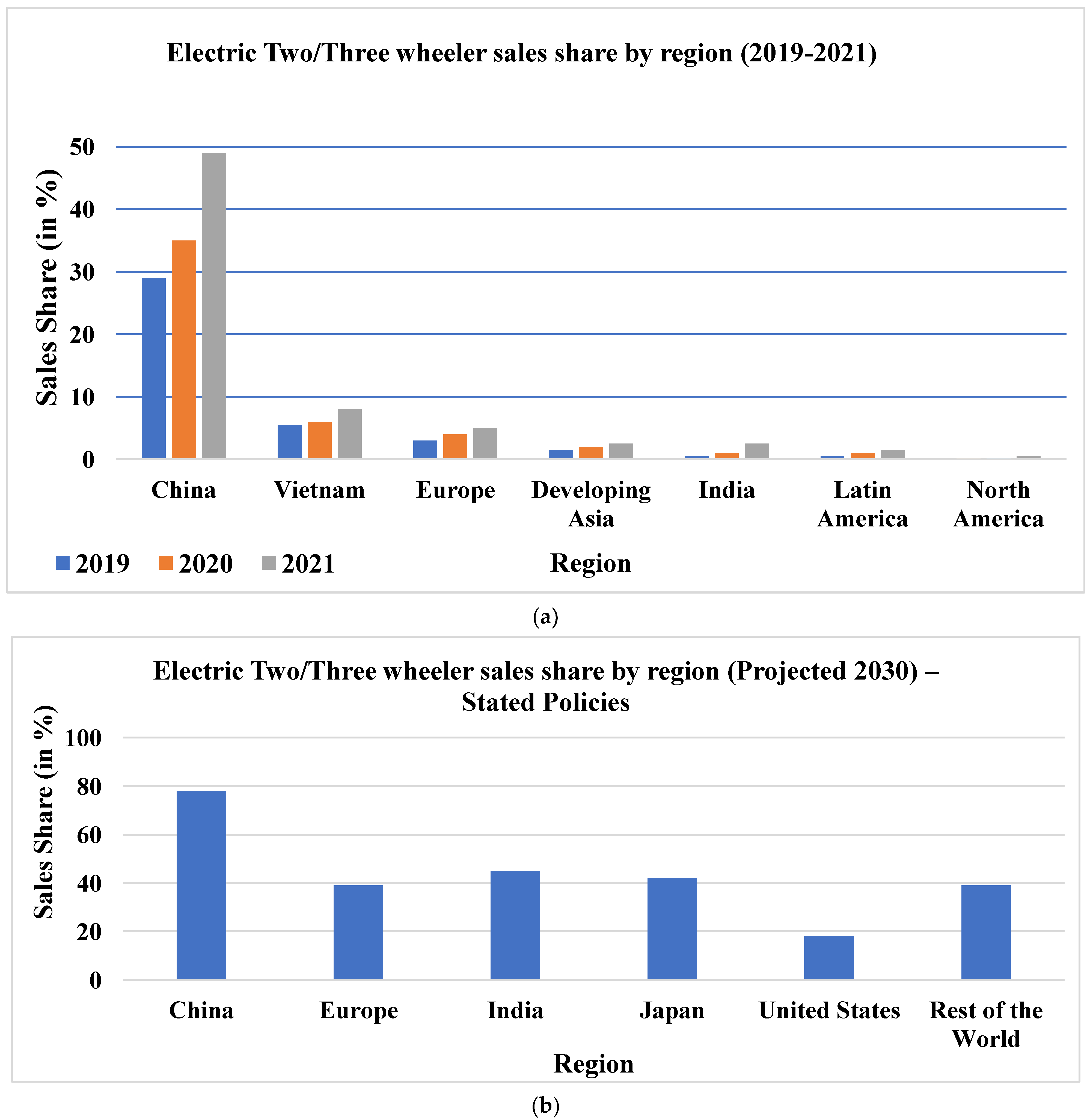


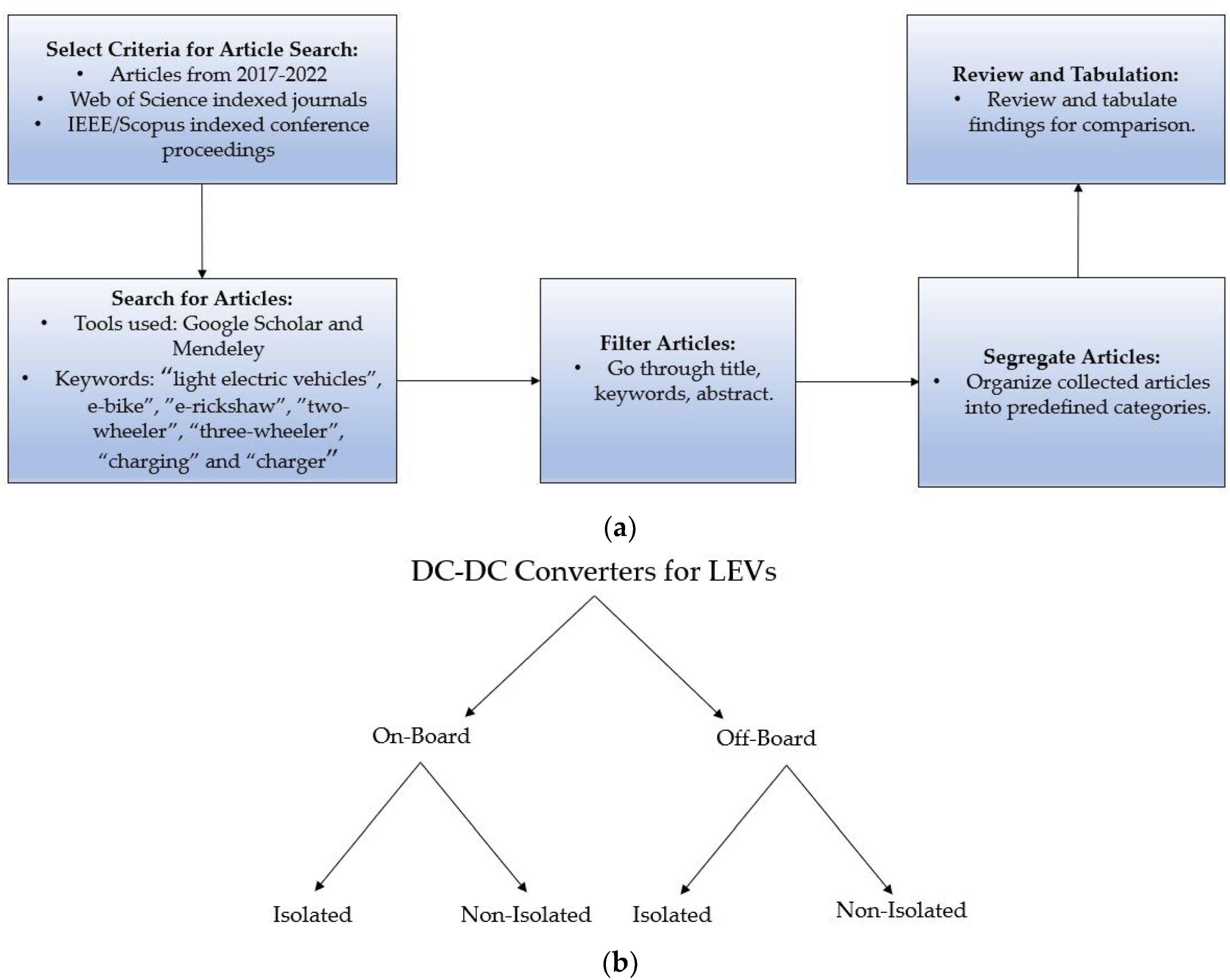
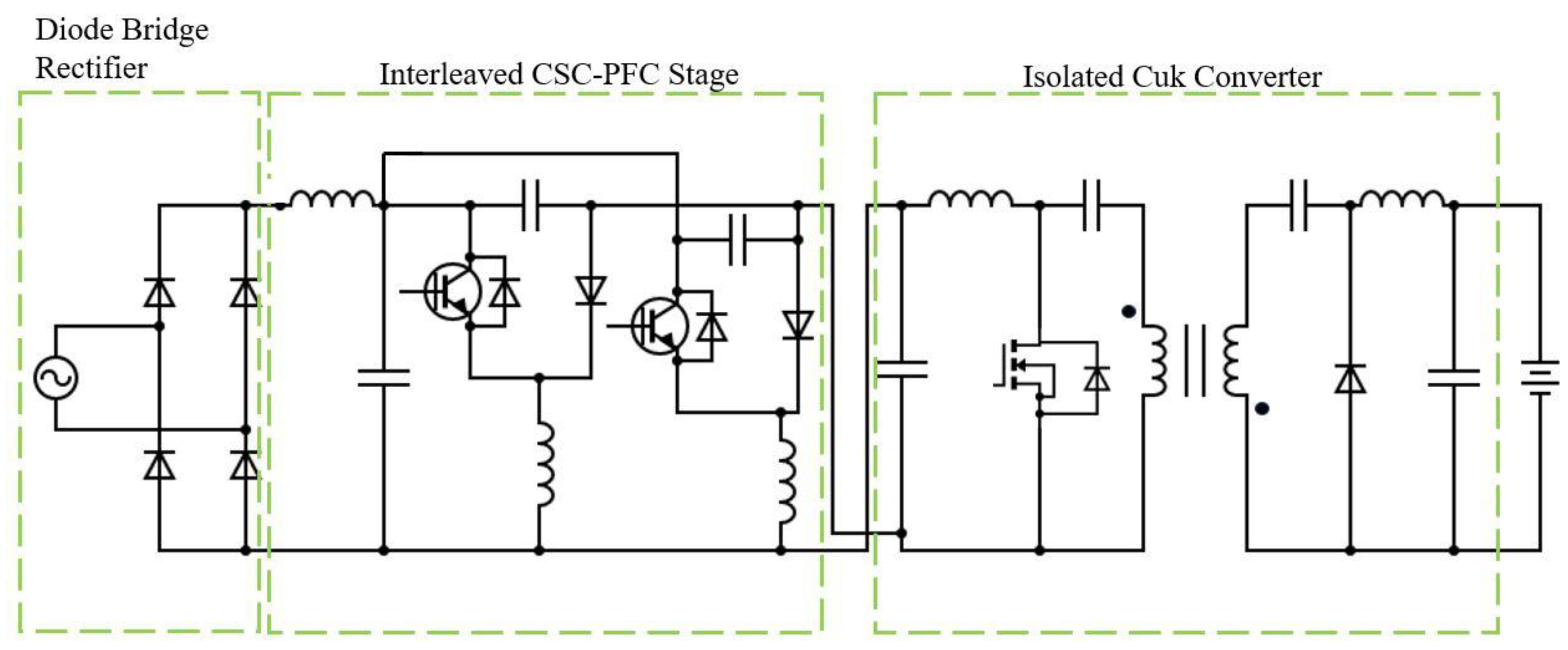
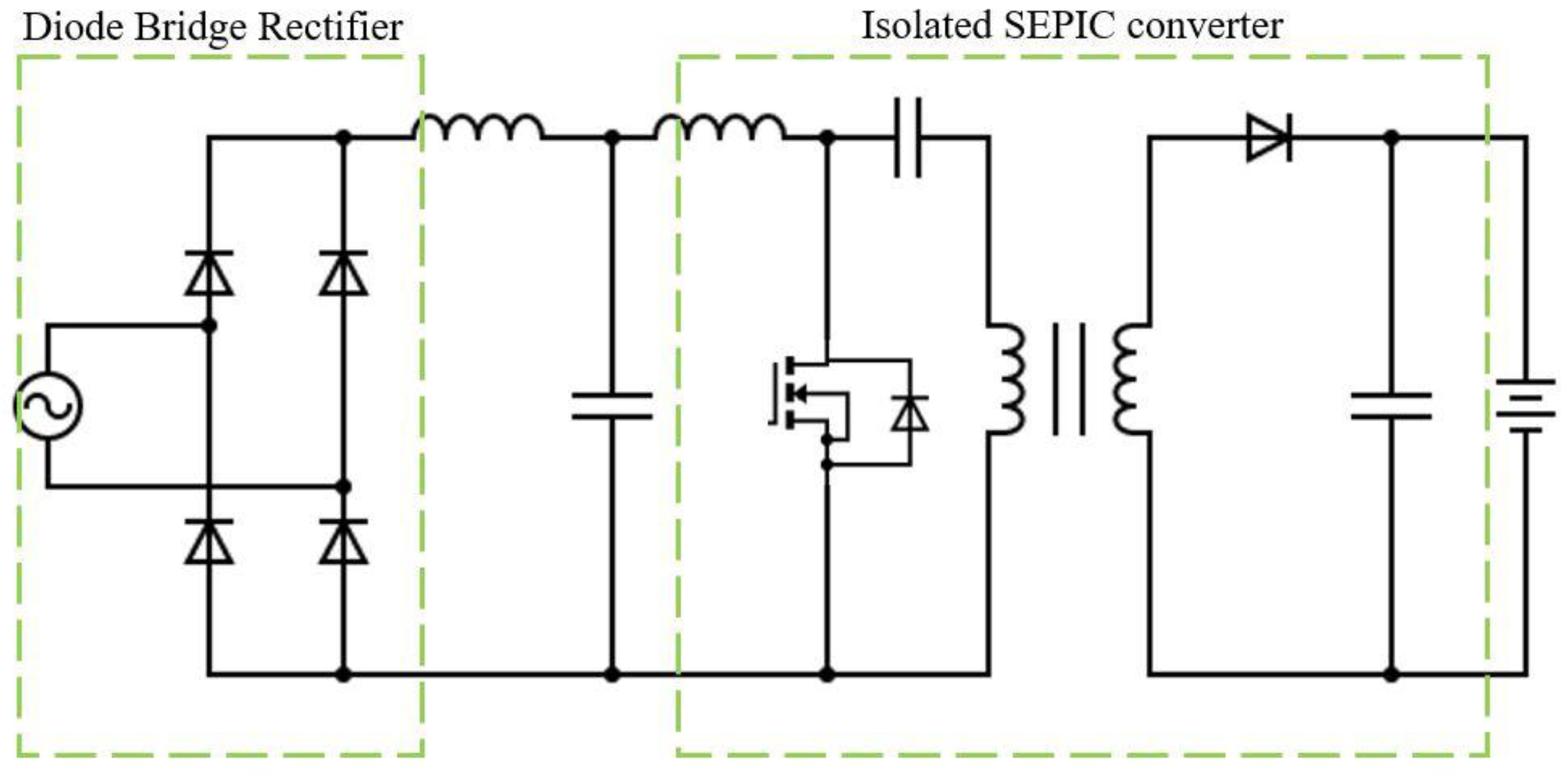
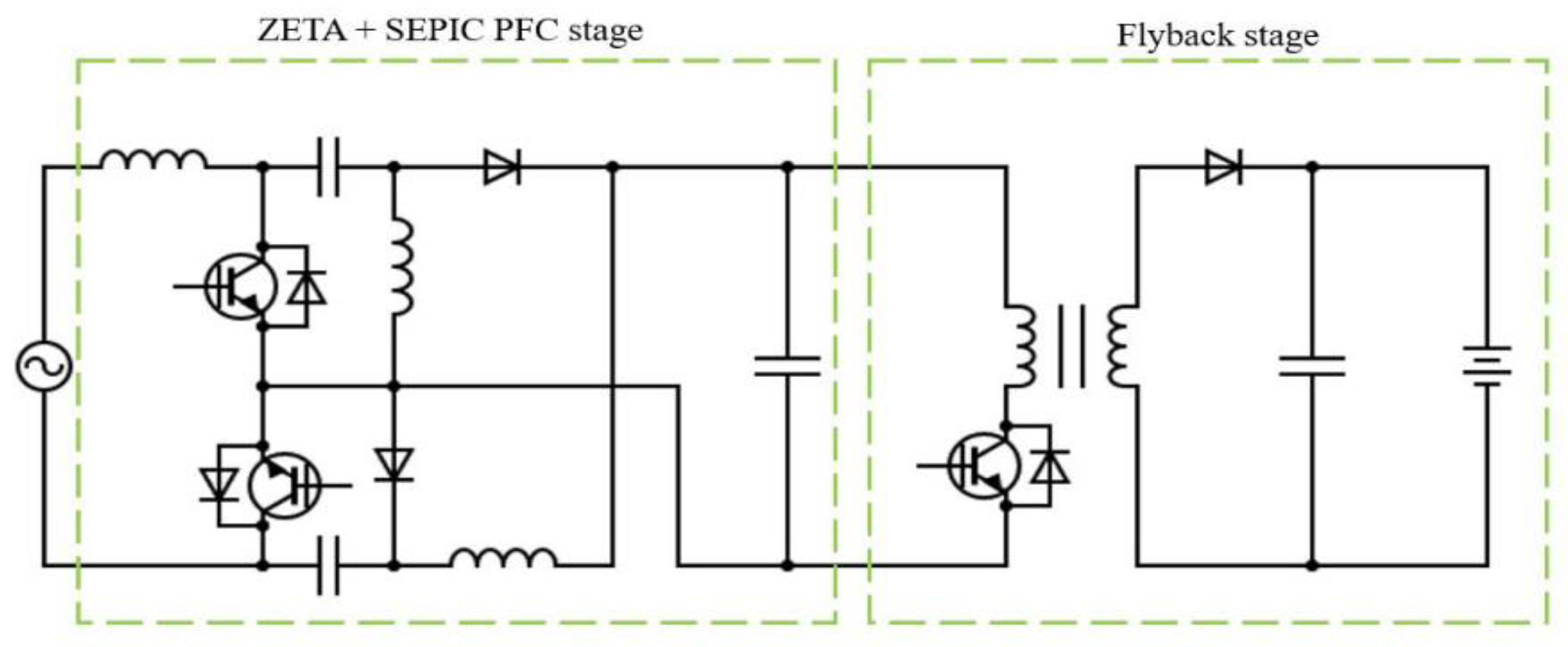
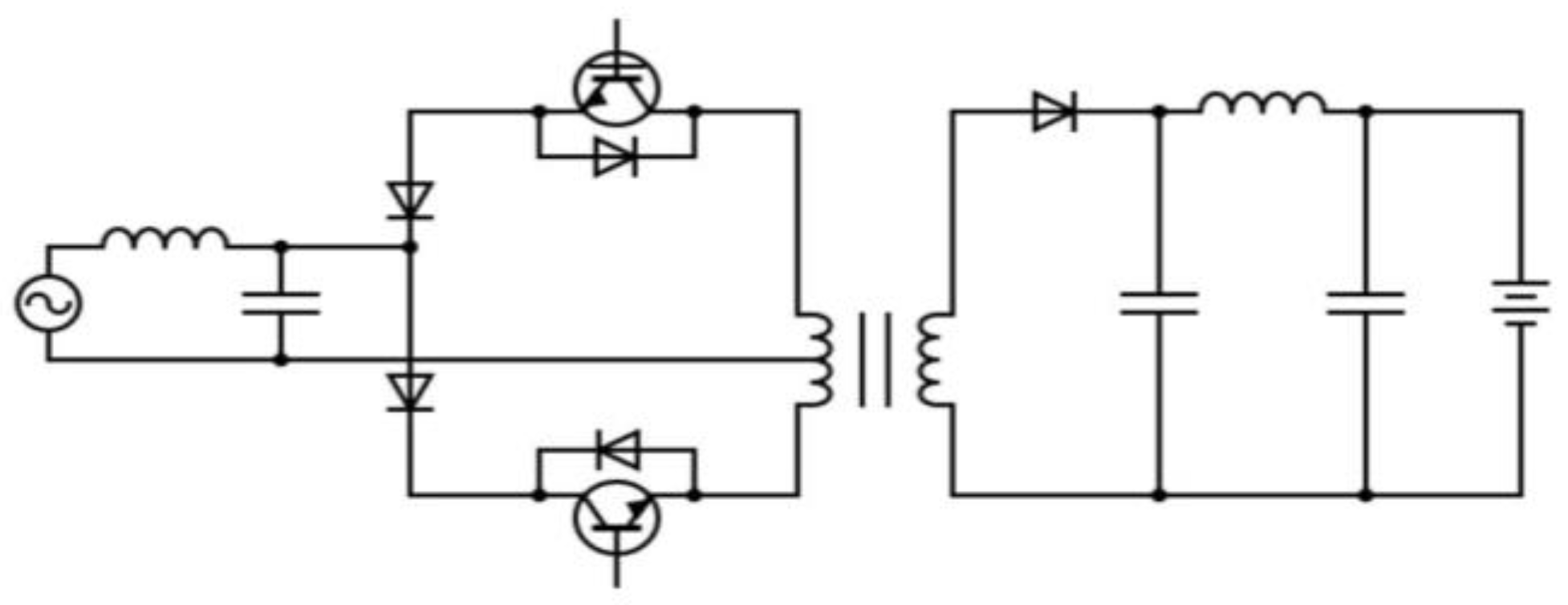
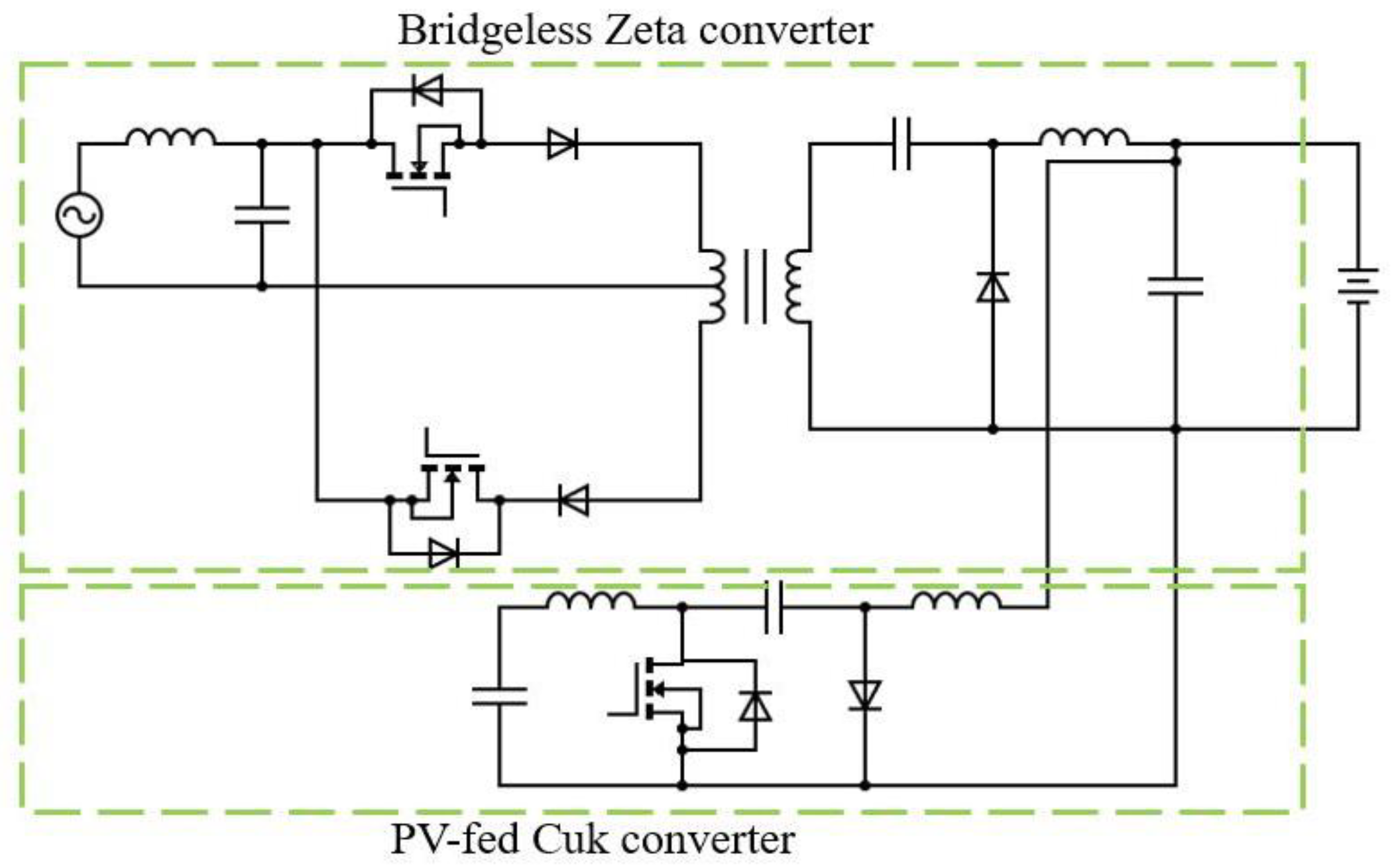


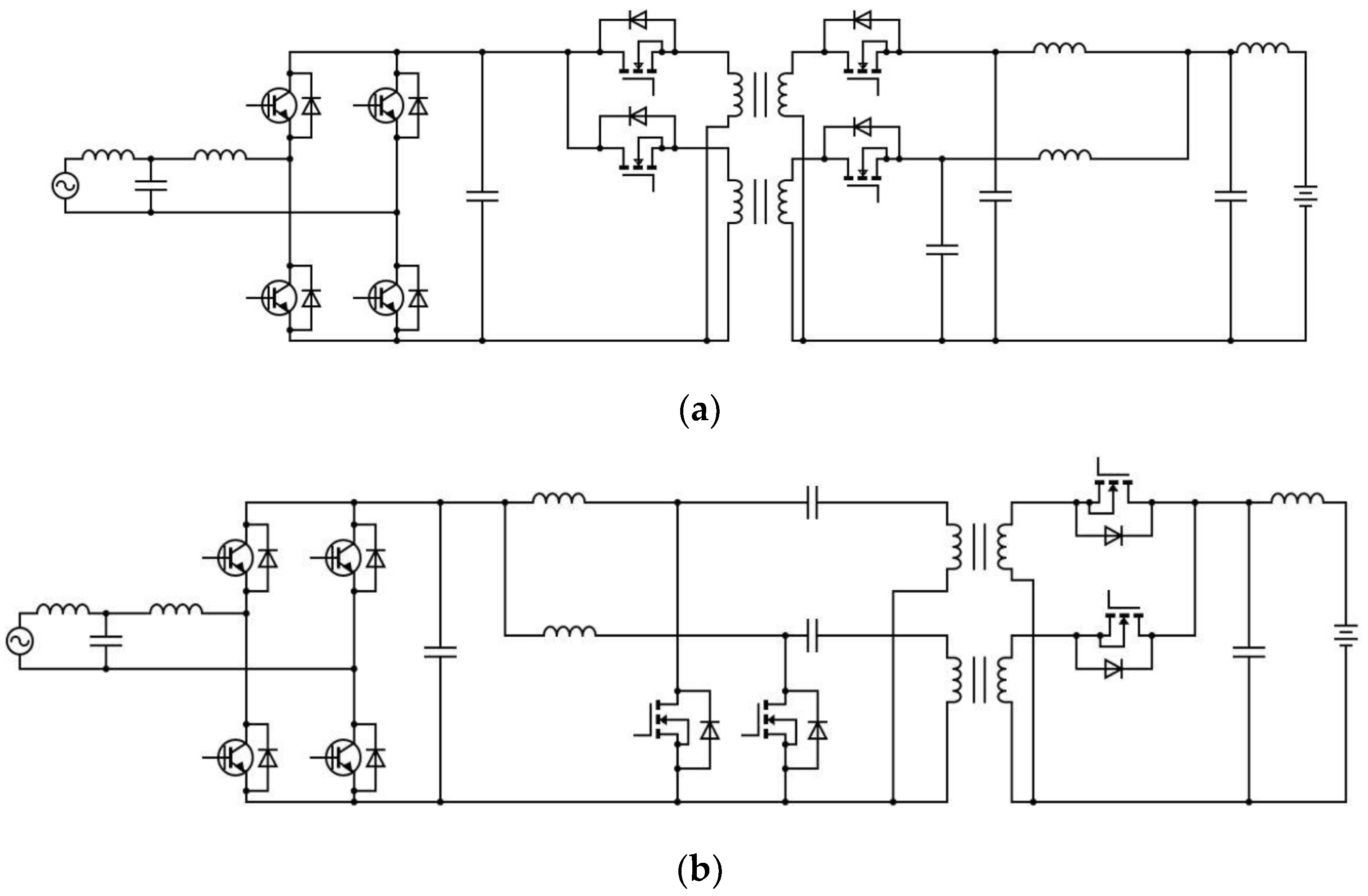
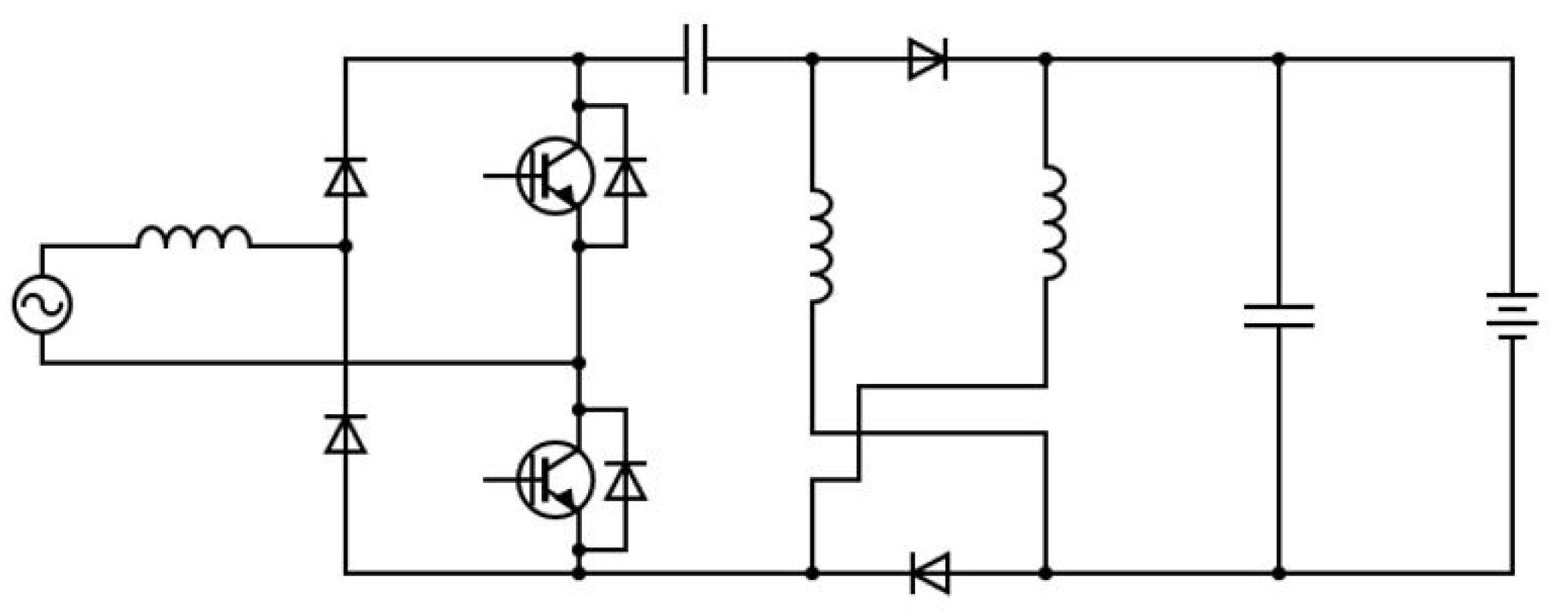

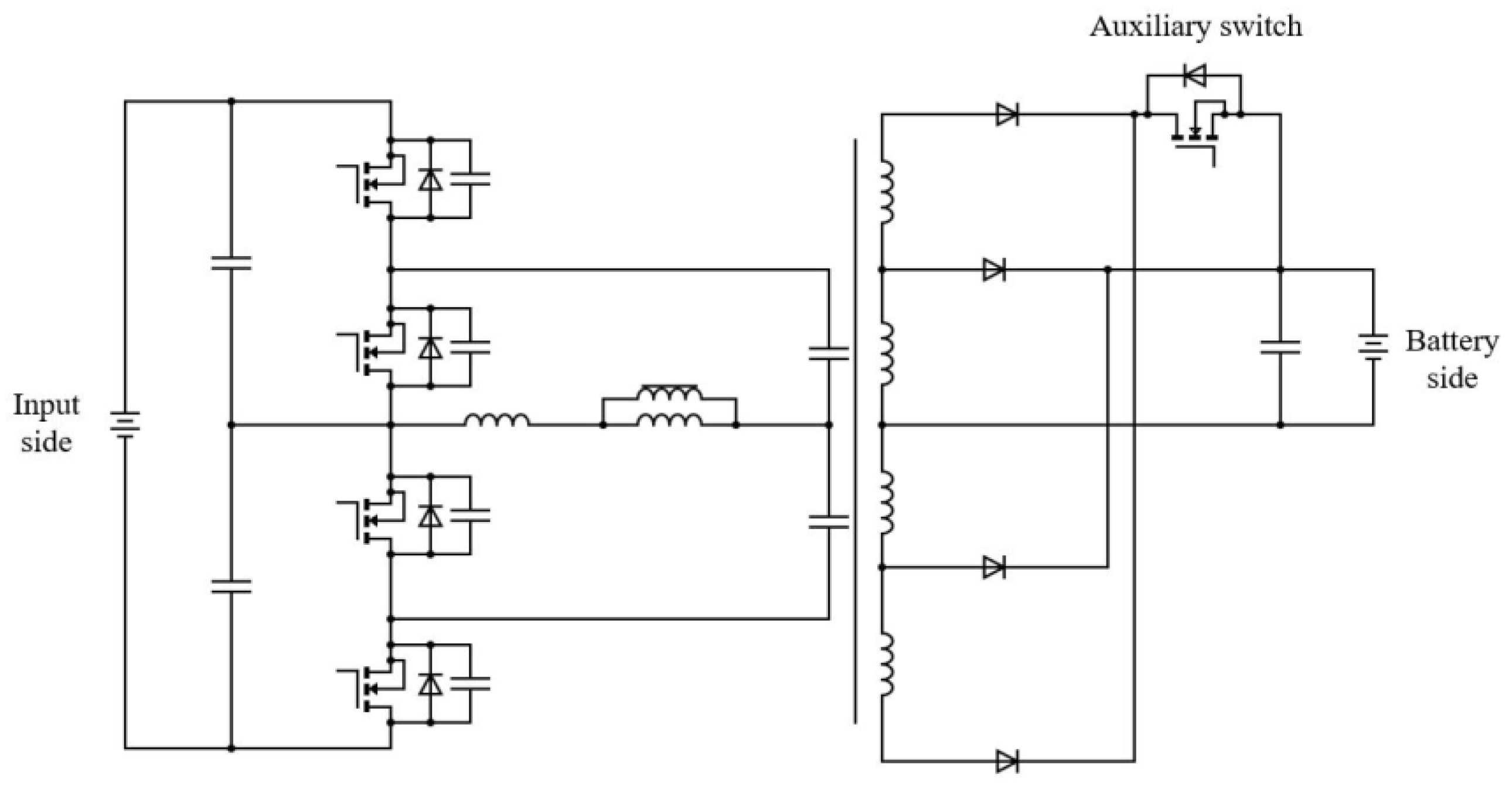
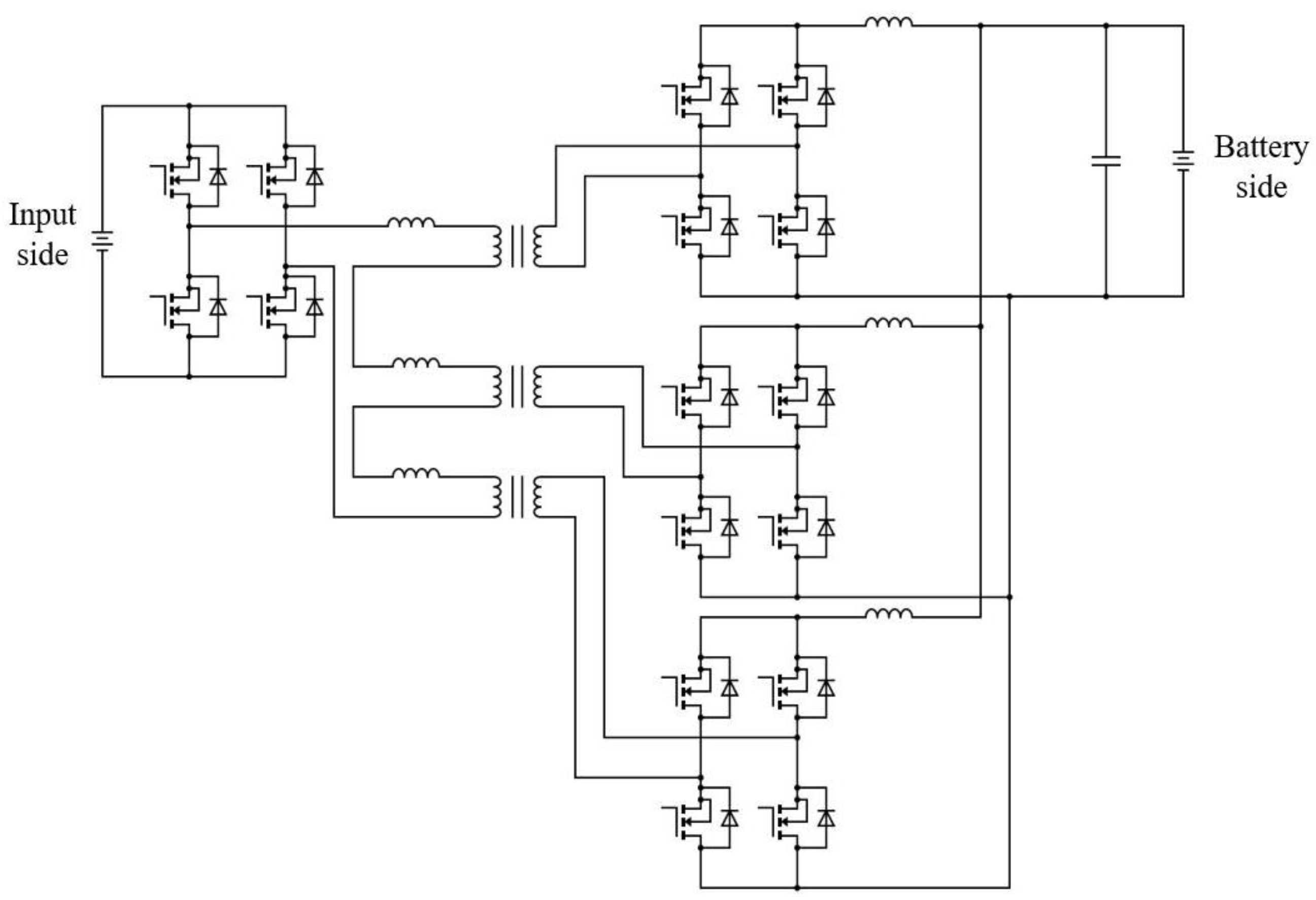
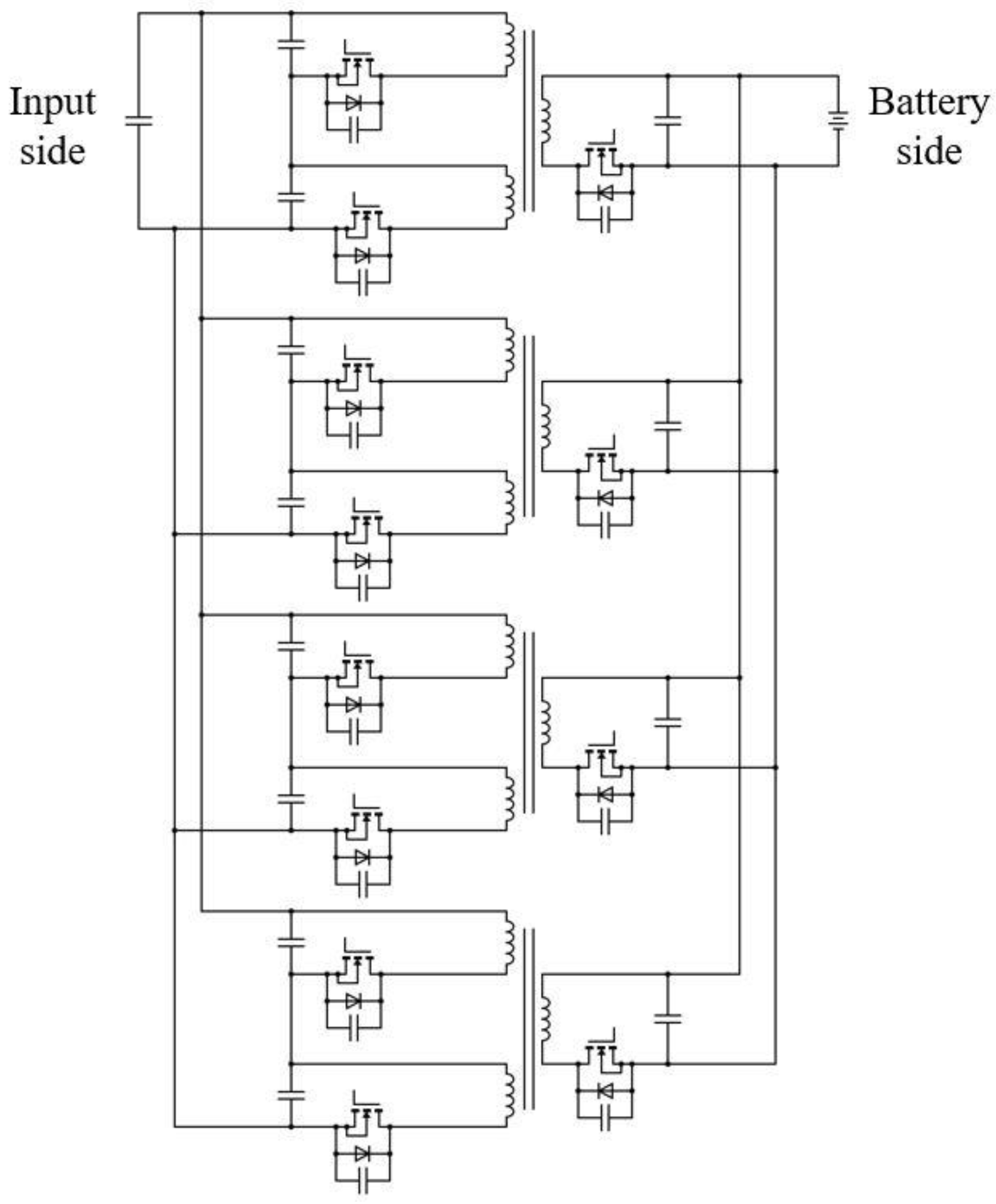
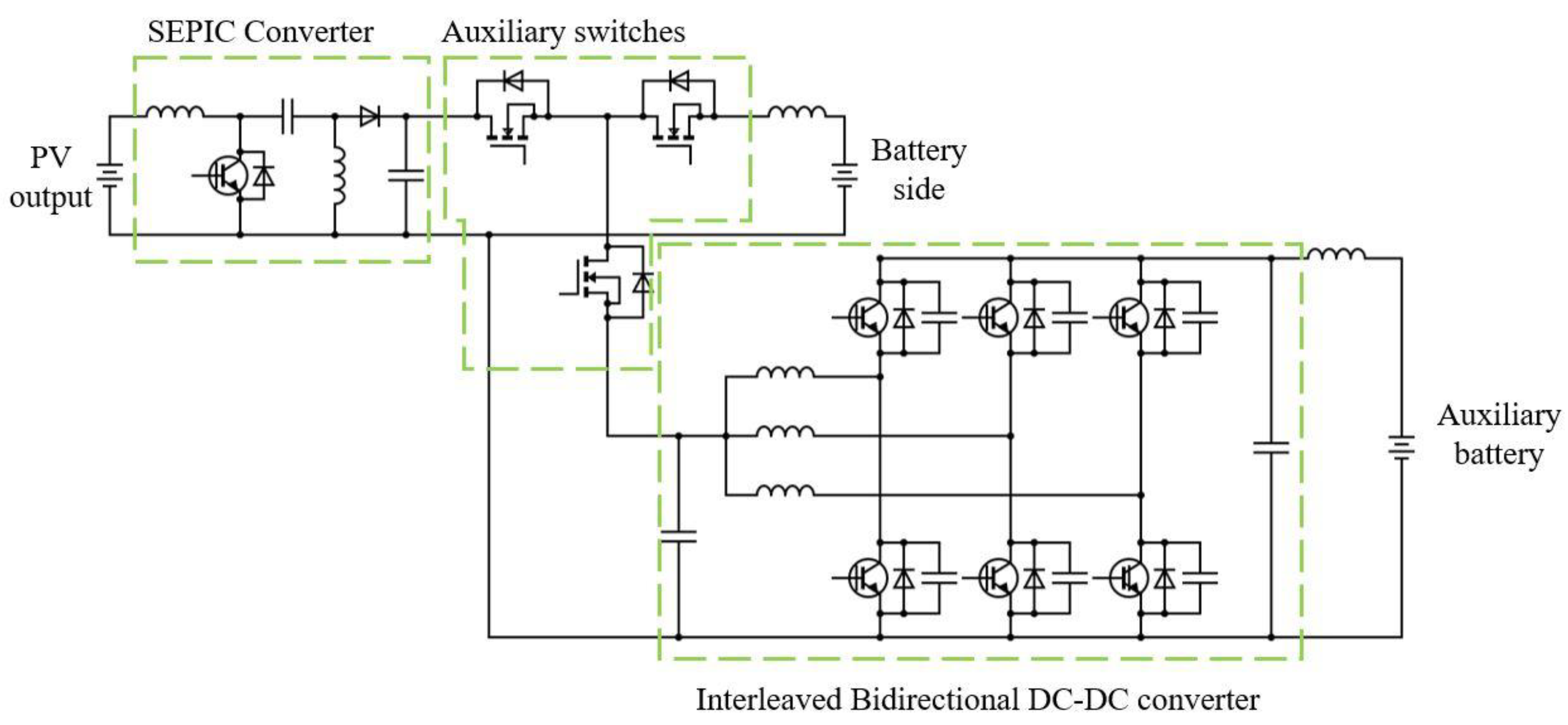
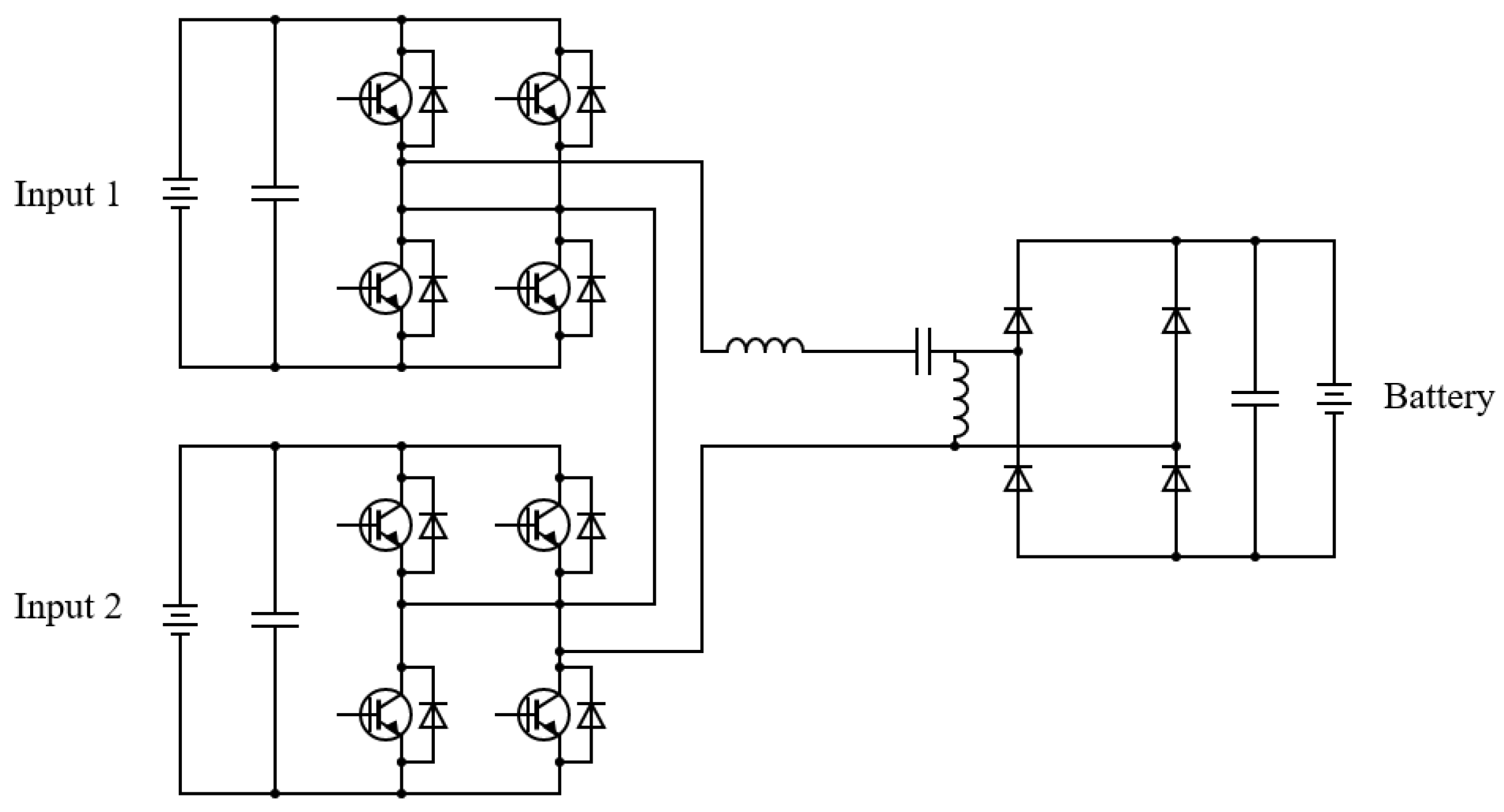
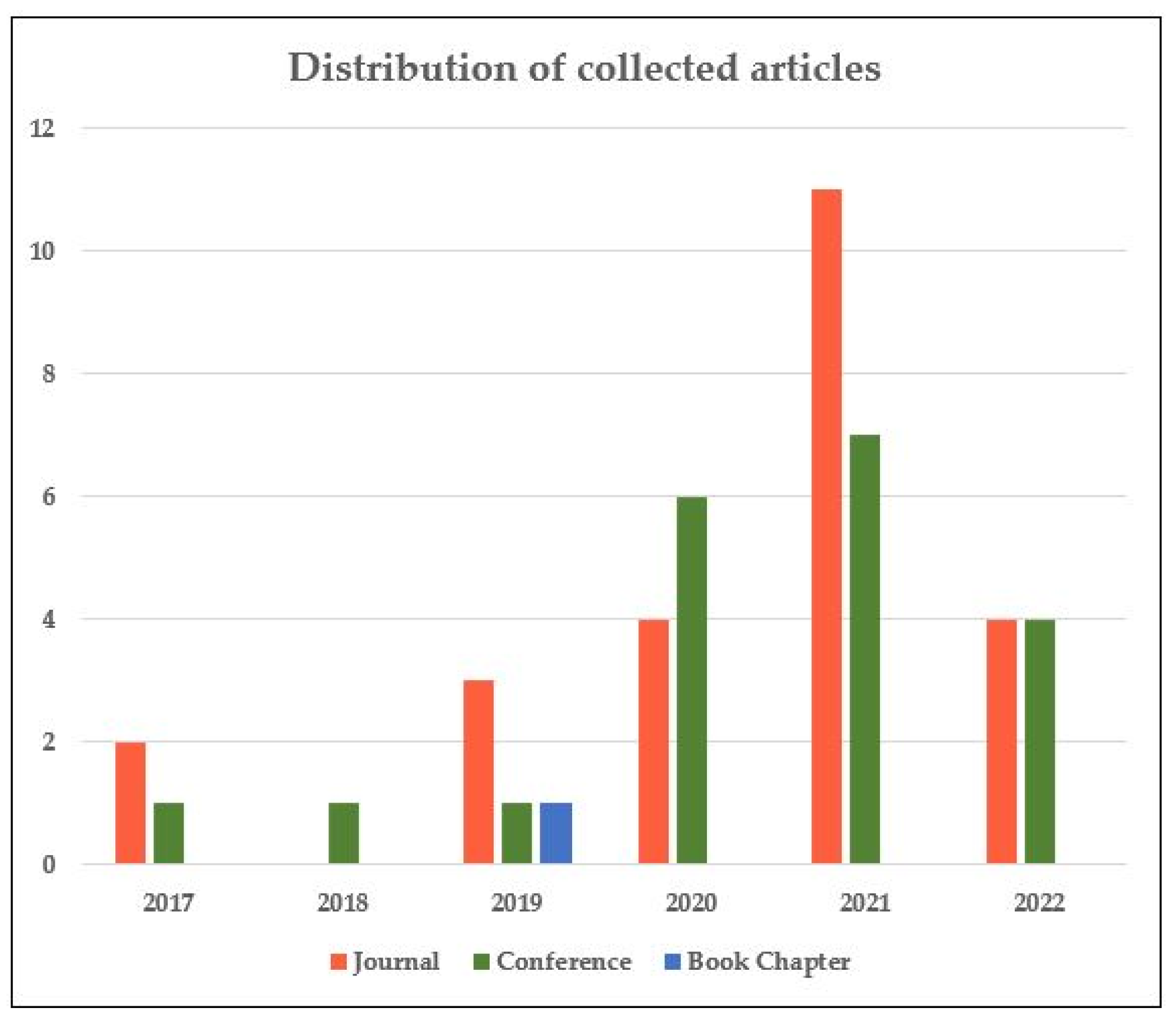
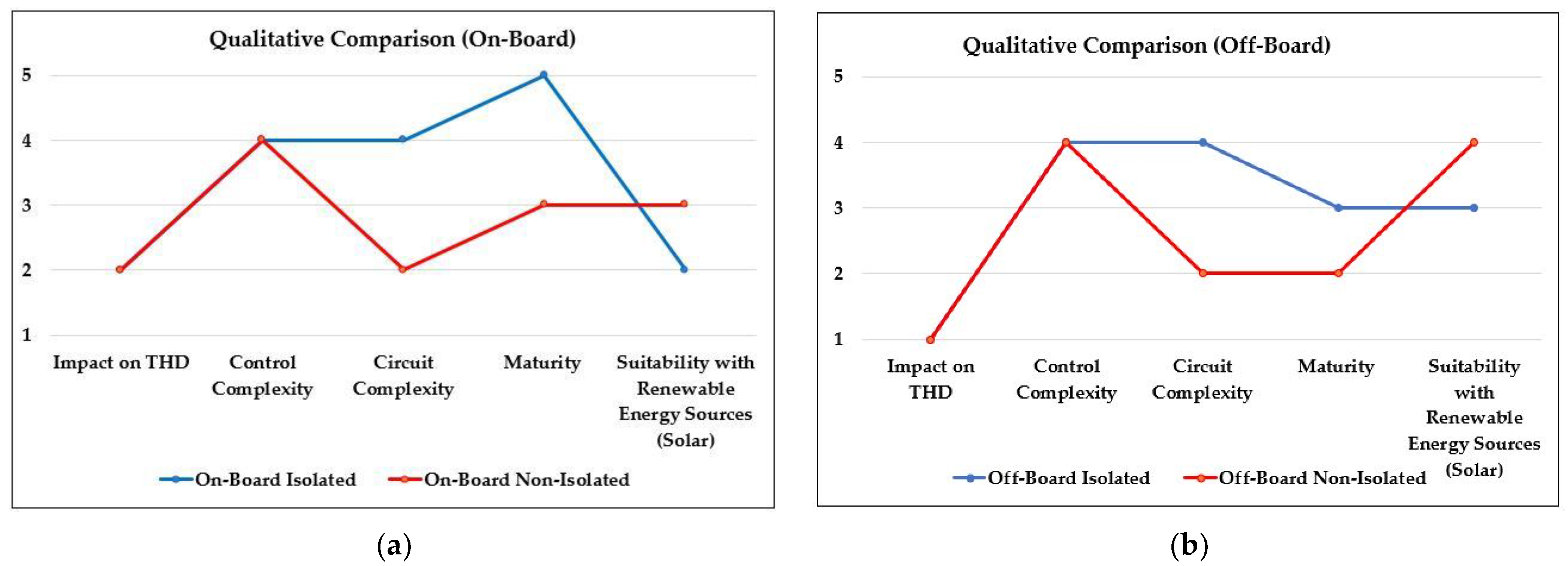

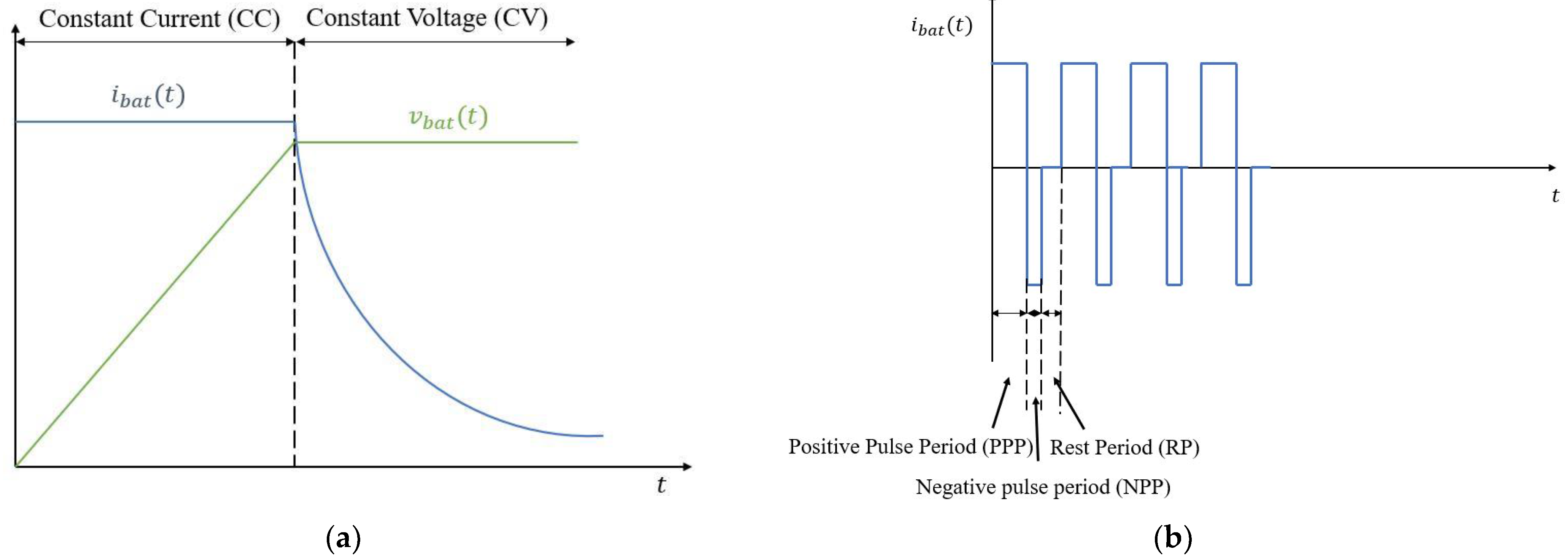
| Type | Model | Battery Type | Voltage Rating | Capacity | Charging Time | Fast Charging |
|---|---|---|---|---|---|---|
| Two-wheeler | Hero Electric Optima CX | Li-ion | 51.2 V | 30 Ah | 4–5 h | N/A |
| Okinawa PraisePro | Li-ion | 72 V | 2 kWh | 2–3 h | N/A | |
| Ather 450 Plus | Li-ion | 51.1 V | 3.7 kWh | 5 h 40 min | 1–2 h | |
| Three-wheeler | Mahindra Treo | Li-ion | 48 V | 7.37 kWh | 3 h 50 min | N/A |
| Piaggio Ape E City/Fixed Battery | Li-ion | 48 V | 7.5 kWh | 3 h 45 min | N/A | |
| Terra Motors Y4A | Lead Acid | 48 V | 140 Ah | 6–8 h | N/A |
| Isolated Topologies | ||||||||
| Ref. | Topology | Component Count 1 | Salient Features | Areas of Improvement | ||||
| L | C | S | D | Tr. | ||||
| [35] | Isolated Cuk converter + interleaved canonical switching cell (CSC) front-end | 4 | 7 | 3 | 3 | 1 |
|
|
| [36] | Isolated SEPIC converter + diode bridge rectifier front-end | 1 | 3 | 1 | 1 | 1 |
|
|
| [37] | Flyback converter with interleaved Zeta + SEPIC converter front-end | 3 | 4 | 3 | 3 | 1 |
|
|
| [38] | Flyback converter with modified Bridgeless Landsman converter front-end | 4 | 4 | 4 | 5 | 1 |
|
|
| [18] | Bridgeless Isolated Positive Output Luo converter | 2 | 3 | 2 | 3 | 1 |
|
|
| [19] | Bridgeless isolated Zeta converter with PV fed Cuk converter | 4 | 5 | 3 | 4 | 1 |
|
|
| [21] | Half-bridge LLC resonant converter with Cuk converter PFC | 4 | 5 | 3 | 2 | 1 |
|
|
| [22] | Full-bridge LLC resonant converter | 2 | 3 | 4 | 4 | 1 |
|
|
| [23] | Half bridge LLC converter with interleaved buck-boost converter front-end | 5 | 4 | 6 | 2 | 1 |
|
|
| [45] | Interleaved isolated Luo converter with voltage source converter front-end | 3 | 4 | 4 | 0 | 1 |
|
|
| [46] | Interleaved isolated SEPIC converter with voltage source converter front-end | 3 | 4 | 4 | 0 | 1 |
|
|
| [47] | Interleaved isolated Zeta converter with voltage source converter front-end | 2 | 4 | 4 | 0 | 1 |
|
|
| Non-Isolated Topologies | ||||||||
| Ref. | Topology | Component Count 1 | Salient Features | Areas of Improvement | ||||
| L | C | S | D | Tr. | ||||
| [53] | Bridgeless switched inductor SEPIC converter | 3 | 2 | 2 | 4 | NA |
|
|
| [54] | Bridgeless switched inductor Cuk converter | 3 | 2 | 2 | 4 | NA |
|
|
| [56] | Interleaved buck-boost converter with voltage source converter front-end | 2 | 2 | 4 | 0 | NA |
|
|
| [57] | Quadratic buck boost converter with DBR front end | 2 | 3 | 2 | 2 | NA |
|
|
| Isolated Topologies | ||||||||
|---|---|---|---|---|---|---|---|---|
| Ref. | Topology | Component Count 1 | Salient Features | Areas of Improvement | ||||
| L | C | S | D | Tr. | ||||
| [16] | LLC resonant converter | 2 | 9 | 5 | 4 | 1 |
|
|
| [60] | Quasi-resonant interleaved flyback converter | 0 | 24 2 | 12 | 0 | 3 3 |
|
|
| [63] | Modular dual active bridge converter | 6 | 1 | 16 | 0 | 3 |
|
|
| Non-Isolated Topologies | ||||||||
| Ref. | Topology | Component count 1 | Salient Features | Areas of improvement | ||||
| L | C | S | D | Tr. | ||||
| [68] | PV-fed SEPIC converter | 3 | 3 | 1 | 1 | NA |
|
|
| [70] | PV-fed SEPIC converter with backup battery-fed interleaved bidirectional converter | 7 | 10 2 | 10 | 1 | NA |
|
|
| [71] | Multilevel LLC converter | 2 | 4 | 8 | 4 | NA |
|
|
| No. | Reference | Salient Features |
|---|---|---|
| 1. | [4] |
|
| 2 | [83] |
|
| 3 | [84] |
|
| No. | Control Technique | Salient Features |
|---|---|---|
| 1. | Constant Current/Constant Voltage (CC-CV) |
|
| 2 | Reflex charging |
|
| 3 | Constant temperature (CT) |
|
Disclaimer/Publisher’s Note: The statements, opinions and data contained in all publications are solely those of the individual author(s) and contributor(s) and not of MDPI and/or the editor(s). MDPI and/or the editor(s) disclaim responsibility for any injury to people or property resulting from any ideas, methods, instructions or products referred to in the content. |
© 2023 by the authors. Licensee MDPI, Basel, Switzerland. This article is an open access article distributed under the terms and conditions of the Creative Commons Attribution (CC BY) license (https://creativecommons.org/licenses/by/4.0/).
Share and Cite
Akhtar, M.F.; Raihan, S.R.S.; Rahim, N.A.; Akhtar, M.N.; Abu Bakar, E. Recent Developments in DC-DC Converter Topologies for Light Electric Vehicle Charging: A Critical Review. Appl. Sci. 2023, 13, 1676. https://doi.org/10.3390/app13031676
Akhtar MF, Raihan SRS, Rahim NA, Akhtar MN, Abu Bakar E. Recent Developments in DC-DC Converter Topologies for Light Electric Vehicle Charging: A Critical Review. Applied Sciences. 2023; 13(3):1676. https://doi.org/10.3390/app13031676
Chicago/Turabian StyleAkhtar, Mohammad Faisal, Siti Rohani S. Raihan, Nasrudin Abd Rahim, Mohammad Nishat Akhtar, and Elmi Abu Bakar. 2023. "Recent Developments in DC-DC Converter Topologies for Light Electric Vehicle Charging: A Critical Review" Applied Sciences 13, no. 3: 1676. https://doi.org/10.3390/app13031676
APA StyleAkhtar, M. F., Raihan, S. R. S., Rahim, N. A., Akhtar, M. N., & Abu Bakar, E. (2023). Recent Developments in DC-DC Converter Topologies for Light Electric Vehicle Charging: A Critical Review. Applied Sciences, 13(3), 1676. https://doi.org/10.3390/app13031676







